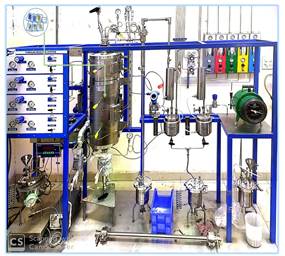New materials & processes for carbon capture and utilization could show new light for global warming challenge
A group of scientists have computationally designed a hybrid material which can absorb greenhouse gas methane, converting it to clean Hydrogen and also simulated a process of capturing carbon dioxide in-situ and converting it to high purity hydrogen from non-fuel grade bioethanol. They have also designed a facility that can test such materials and help further carbon capture research at the institute.
Given the global warming potential of greenhouse gases, scientists are trying to explore innovative methods of absorbing these gases and converting them to useful substances. New materials that can play dual role of absorption as well as conversion is the new challenge area for scientist in carbon capture innovation.
Responding to the challenge, in a series of researches on carbon capture and utilization scientists from Indian Institute of Chemical Technology (IICT), Hyderabad have not only computationally designed a hybrid material that can capture methane and also act as catalyst to convert it to high purity hydrogen, but also simulated and designed a process for in situ capture of carbon dioxide and its conversion to high purity hydrogen from non-fuel grade bioethanol through a mechanism called the optimized intensified chemical looping reforming. The later research has been published in the Elsevier journal Chemical Engineering and Processing.
They researchers have also fabricated a facility that can further carbon capture and conversion research at the institute. The facility, a dual operational fixed cum fluidized bed reactor system (FBR) can carry out sorption enhanced steam methane reforming (SESMR) for high purity H2 production based on the modelling and preliminary experimental studies.
The FBR facility has been successfully commissioned recently in Jan 2022 at CSIR-IICT, Hyderabad, under a Mission Innovation Project supported by Department of Science and Technology to IICT Hyderabad. It is unique and available for the first time in the country to test the performance of dual functional materials for SESMR in fluidized bed reactor system. SESMR offers specific advantages of in-situ CO2 removal through sorbents and thereby overcomes the equilibrium limitations of steam reforming and leads to high purity H2 production.
Potential dual functional materials identified from theoretical predictions are now being synthesized and simultaneously FBR operating conditions are being optimized for existing sorbent/catalyst materials for meeting increasing challenges of carbon capture and utilization and associated research.

Fig. 1 Snapshot of FBR system installed at CSIR-IICT
Publications: 1) Shadab Alam, N. Lingaiah, Y. Soujanya, C. Sumana, Intensified chemical looping reforming processes with in-situ CO2 capture for high purity H2 production from non-fuel grade bioethanol Chem. Eng. Process.: Process Intensif., Vol. 171,2022, 108733, ISSN 0255-2701, https://doi.org/10.1016/j.cep.2021.108733. 2) Improved Prediction of CO 2 Solubility in Physical Solvents using Kernel Ridge Regression Models with Key Descriptors Selection, Submitted.

